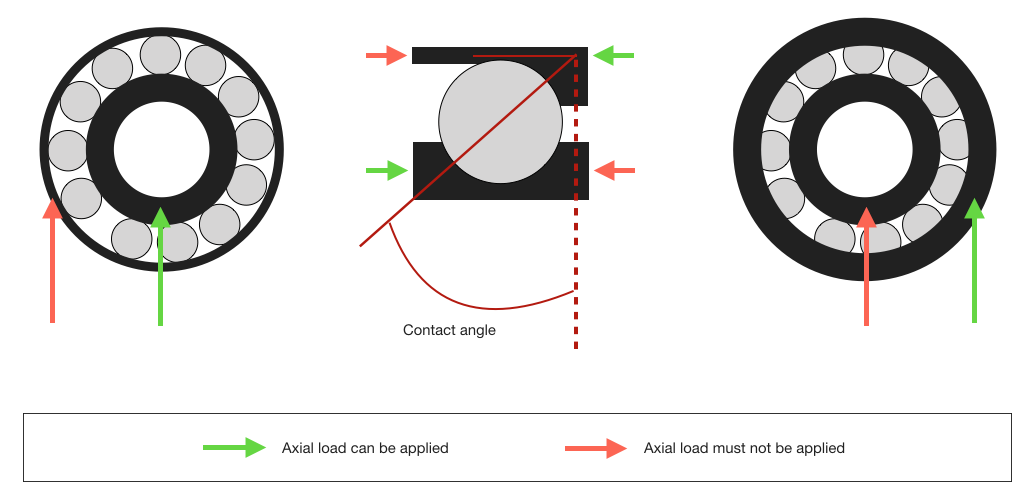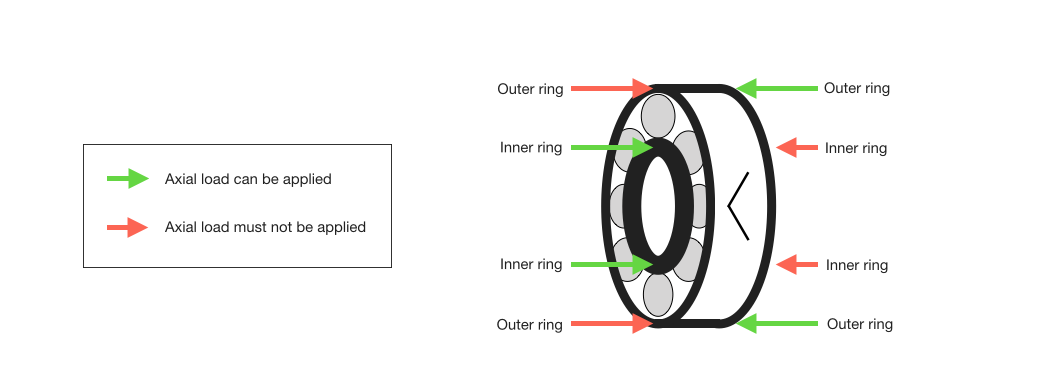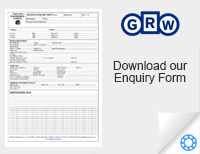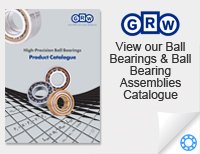Angular contact ball bearings (also known as spindle bearings) are bearings where the inner and/or outer ring shoulders are relieved. Relieving the shoulder allows the ball complement to be changed to give greater load capacity (larger balls or a greater number of balls) and a stronger retainer, allowing higher speed and better endurance.
The axial load carrying capacity of angular contact ball bearings increases as the contact angle increases. The contact angle for angular contact bearings is defined as the angle between the line that joins the points of contact of the ball and the raceways in the radial plane (along which the combined load is transmitted from one raceway to another), and a line perpendicular to the bearing axis (see fig 1).

Fig 1 – Direction and placement of allowable axial loads for angular contact bearing with relieved outer ring shoulder. and definition of angular contact bearing contact angle.
Key Benefits of angular contact ball bearings
Angular contact bearings allow higher operational speeds and better endurance. The reduced outer ring shoulders in angular contact bearings create a greater offset during bearing assembly which allows an increase to the bearing complement (through using bigger and/or more balls) and also allowing the use of stronger cages both of which result in being able to operate at higher speeds with better endurance.
For more on retainers and cages see the retainers and cages section in the GRW catalogue.
GRW Angular Contact (Spindle) bearings
GRW angular contact (spindle) bearings are generally single-row ball bearings with either the inner or outer ring shoulder reduced. Angular contact (spindle) bearings have a nominal contact angle of 15° (C) or 25° (E) depending on the required axial load (other special contact angles could be supplied). They can be subjected to axial loads in one direction and normal radial loads. The direction of the applied axial load on the face of the bearing outer ring is shown by a “V” marking on the outer ring (see fig 2).
GRW angular contact ball bearings are suitable for applications requiring precision while carrying high loads combined with high speeds, such as high speed machining spindles.
PLEASE NOTE: It is imperative that axial load is applied in the right direction.

Fig 2 – The direction of applied axial load on the outer ring face of GRW angular contact bearings is shown by a “V” marking on the outer ring.
GRW Angular Contact (Spindle) ball bearings are characterised by the following properties:
- Manufactured quality of ISO P4 (or ABEC7) or better.
- Rings generally made of corrosion-resistant SV 30 high-grade steel.
- Steel balls or ceramic balls where centrifugal force is an issue. Silicon Nitride balls are less than half the density of traditional bearing steels.
- Solid retainer made from fibre-reinforced phenolic resin or special materials, for applications requiring greater strength/endurance/involving higher temperatures.
- 15° (C) or 25° (E) contact angles are standard though special angles can be supplied depending on axial load).
- Bearings can be matched and ground to three pre-defined preload classes (Light, Medium, Strong) or to a specific customer defined preload.
- Oil, grease or special lubrication available.
- Open and some shielded versions available.
Matched Bearing arrangements (also see duplex bearings)
- Face to Face > < – Less stiff (for mis-alignments)
- Back to Back < > – Stiff (for stability)
- Tandem < < – Higher axial loads in one direction
Shielded angular contact (spindle) ball bearings:
- Non-contact shields do not cause additional torque.
- Standard non-contact shields are ‘Z’ pressed steel (VZ) a combination of Viton rubber and steel offering excellent temperature and contamination resistance.
- The very small, closely toleranced sealing gap between shield and ring provides protection against the ingress of contamination such as dust particles.
Open angular contact (spindle) ball bearings:
- Standard configuration has large balls for optimum utilisation of bearing geometries and a solid retainer for higher bearing capacities.
- The outer ring has only one partial shoulder remaining. This partial shoulder is necessary to prevent the bearing separating.
- Solid outer ring guided retainer with a low profile cross-section is particularly well suited for oil injection lubrication or oil mist.
Handling angular contact (spindle) ball bearings
- GRW recommends leaving the bearing in its airtight packaging until you are ready for assembly.
- Extreme cleanliness during assembly is recommended.
- Avoid dropping or to subjecting the bearing to any kind of impact loading.
- Angular contact (Spindle) bearings are designed to withstand axial loads in only one direction. The “V” laser marking on the outer ring denotes the direction of load applied to the bearing outer ring.
- Using the proper assembly tooling will prevent damage of the bearing.
- Duplex bearings labeled (DB), (DF), or (DT) are always packed in pairs and can only be used as pair in the specified configuration.
- Universally ground duplex bearings can be used in a combination of configurations, i.e. you can combine bearings from different packages or lots. These bearings may be assembled in any duplex arrangement. Universally ground duplex bearings are sold individually as they can be used in odd numbers.
- Prior to using these bearings in application GRW has found that a run in period at high speed helps to distribute the lubricant and is beneficial for the bearing.
For more on the handling of GRW precision ball bearings please see our precision bearing handling guide.
For a full guide to GRW angular contact (spindle) bearing options including dimensions, load ratings, limiting speeds and preloads please refer to the latest GRW catalogue or contact us.



